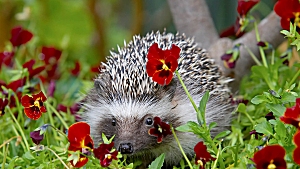 |
SPIRIT
LODGE
LIBRARY
Totem
Animals
Page
76
|
(Main
Links of the site are right at the bottom of the page)
Some of the links for the 197 pages in this Totem Animals section
are below. For the rest please go HERE
HEDGEHOG MEDICINE
By CinnamonMoon

*Ted Andrews/Animal-Wise:
Keynote: Inquisitiveness and curiosity, misunderstanding, defensiveness.
Hedgehog Dad was celebrated in Rome in a festival on February
2. Over the centuries it would
become Americanized into Groundhog Day for the forecasting of
weather. The Roman writer
Pliny spoke of how hedgehogs rolled themselves into apples,
sticking their quills into them and
carrying them back to their burrows.
Hedgehogs were killed by the thousands in some parts of Europe.
During the reign of Queen
Elizabeth I, it was believed that this creature was responsible
for the destruction to farm crops
and for carrying the plague. A bounty of three pence was paid
for every hedgehog killed.
In European folklore, they were accused of suckling dairy cows.
Even Shakespeare in A
Midsummer Night's Dream had little positive to say about them:
You spotted snakes with double tongue,
Thorny hedgehogs, be not seen;
Newts and blindworms do no wrong;
Come not near our Fairy Queen.
Today the hedgehog is protected in most countries and is treated
with a little more
understanding. Often when the hedgehog appears we find ourselves
in position where others
areound us just don't seem to understand who we are and what
we are doing. We seem very
alone, as if others are overlooking who we are beyond the outer
covering. This can make us want
to roll up into a ball and hide a little. Sometimes it also
indicates that we may not understand
fully others that are presently in our life, and there may be
a need to be more sensitive.
In cartoons and books, the hedgehog is often depicted as a whimsical
creature with a natural
curiosity and inquisitiveness about it. When it appears in our
life, our own sense of curiosity
about the world around us will increase. Now is a time to explore,
but with little cautiousness.
Hedgehogs have been around since the age of the dinosaurs, and
its natural habitat ranged from
southern Europe to South Africa. Two main types exist today,
the European and the African. In
the wild, their range is about 500-1000 feet surrounding their
burrows. Gardeners love
hedgehogs because they will consume 1/3 of their weight each
day in slugs, snails, and insects.
These solitary insectivores are wonderful companions to gardening
environments.
The hedgehog has a natural set of defenses that will discourage
most predators. its quills are
actually stiff hollowed hairs. The hedgehog can roll itself
up into a ball so that the quills
crisscross for a strong defense against anyone touching it.
The defensive posture of rolling into a ball is one of its most
peculiar characteristics. In Alice in
Wonderland, the mad queen used a rolled-up hedgehog as her croquet
ball. At times in our life,
we all need to roll ourselves up in a ball and be more protective.
The hedgehog teaches us to explore and follow our natural curiosity,
but it also shows us how to
be more protective of ourselves as well. Even though others
may not understand our peculiar
habits or us, we have a wonderful way of stimulating the curiosity
and inquisitiveness within
their natures. We cannot have a hedgehog as part of our life
without touching others in unique
and wonderful ways.
Do we need to be more defensive about the pests in our life?
Are we too open and exposed? Do
we need to pull ourselves in a ball and be more protective?
Are we being too defensive and not
allowing anyone to touch us? If no one can touch us, then we
cannot be hurt. Are we protecting
our emotions and heart?
*D.J. Conway/Animal Magick:
This small mammal is not found in the western hemisphere at
all, but is widespread throughout
most of the old world, except for Australia and Madagascar.
In Europe, the common hedgehog is
best known. Its territory extends from England and Ireland all
the way east to Siberia,
Manchuria, and Korea. In countries where the Winters are cold,
the hedgehog hibernates. In
certain areas of China, this animal is considered sacred and
treated with respect.
Hedgehogs are generally small enough to hold in your hand. They
are usually chocolate-brown
in color with yellowish-white tips on the spines. Although their
spines are sharp, they are not
barbed like the porcupine. With care, you can pick up a hedgehog
without hurting yourself.
When threatened, they curl up in a ball, spines outward, until
the enemy goes away. They
generally eat slugs, worms, insects, frogs, and snakes.
The hedgehog's reputation depends upon the culture you study.
In China it was considered
sinister. Aristotle wrote that it could predict the weather.
It was an emblem of the Sumerian
goddess Ishtar as Great Mother.
Small figurines of hedgehogs have been found in Minoa and Mycanae,
along with their pictures
painted on vases. In Greece, Rhodes, and Etruria before the
sixth century B.C.E., vases shaped
like hedgehogs were used for infant burials. This suggests a
connection with the Goddess and her
regenerating womb.
Superstitions: The Irish said the hedgehog was a witch
in disguise who sucked cows dry. In
Europe, the hedgehog is considered to be a weather prophet.
If it comes out on February 2 it
stays out, the worst of Winter is over. In the United States,
this is applied to the woodchuck. The
hedgehog will roll in dropped grapes, sticking them on his spines
to carry them home with him.
Magickal Attributes: Less defensiveness and seriousness in life.
Appreciate life more. Building
defenses and protective barriers that discourage negative people.
Reconnecting yourself with the
Crone aspect of the Goddess.
*Note: See Porcupine as the two are closely related in myth,
folklore, and superstitions.
*Zolar/Encyclopedia of Signs, Omens, and Superstitions:
In general it is said that hedgehogs bring bad luck. If you
see one, it should be killed
immediately. Tradition has it that witches possess the ability
to transform themselves into
hedgehogs.
According to medieval tradition, the hedgehog could roll itself
in apples and carry them away. In
Europe, they are believed able to drink the milk of cows, and
their presence in a barn was said to
keep cows from calving.
Should a woman accidently place her foot on the head of a hedgehog,
it was believed she would
give birth to one.
Traditionally, the hedgehog leaves its hibernation on February
2, Candlemas Day. Should he stay
outside, spring is said to be coming.
*Lady Stearn Robinson & Tom Gorbett/The Dreamer's Dictionary:
You'll have a prickly choice to make if you dreamed of this
little animal; you'll be able to make
either gain or some progress but at the expense of a friend.
|
Libraries
are on this row
|
|
|
INDEX
Page 3
(Main Section, Medicine Wheel, Native Languages &
Nations, Symbology)
|
|
INDEX
Page 5
(Sacred Feminine & Masculine, Stones & Minerals)
|
|
|
|
|
|
©
Copyright: Cinnamon Moon & River WildFire Moon (Founders.)
2000-date
All rights reserved.
Site
constructed by Dragonfly
Dezignz 1998-date
|
|